|
|
THE
MESSENGER EDITOR REPORT
Bent's Old Fort's
Educator Encampment
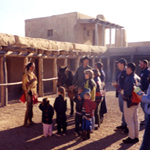
June
8 – 12, 2006 (1845)
The
Educator's Encampment is a program produced by the NPS staff
at Bent's Old Fort Historical Site in La Junta, Colorado. It
is intended for educators, be they teachers or volunteers to
immerse themselves at an historical site to learn and hone
those skills appropriate for a person associated with Bent's
Fort during its existence in the 1833-1848 time period. The
first day is spent in the classroom. The remaining 2 and ½
days are spent learning and practicing those skills.
John
Luzader of the Living Museums of the West, discussed
Tilden's Principles for Interpretation. (1) Bill Gwaltney of
the NPS, spoke about research and development of a
historically accurate living history persona. Barbara
Ingles, a retired grade school teacher,
discussed integrating Bent's Fort history into all
academic areas of study. Greg Holt, NPS at Bent's Old Fort,
discussed the history and social impact of Bent's fort in
its day. He also covered 21st century intrusions
and how to handle them.
John
Luzader and Bill Gwaltney then inspected our clothing. Some
of the folks didn't have period clothing or had
inappropriate clothing. For example, one trader was
outfitted as a long hunter. By the time Greg Holt, John
Luzader and Bill Gwaltney were done with him he was the
epitome of a trader. The fort has 1500 pieces of clothing so
all the folks ended up clothed correctly.
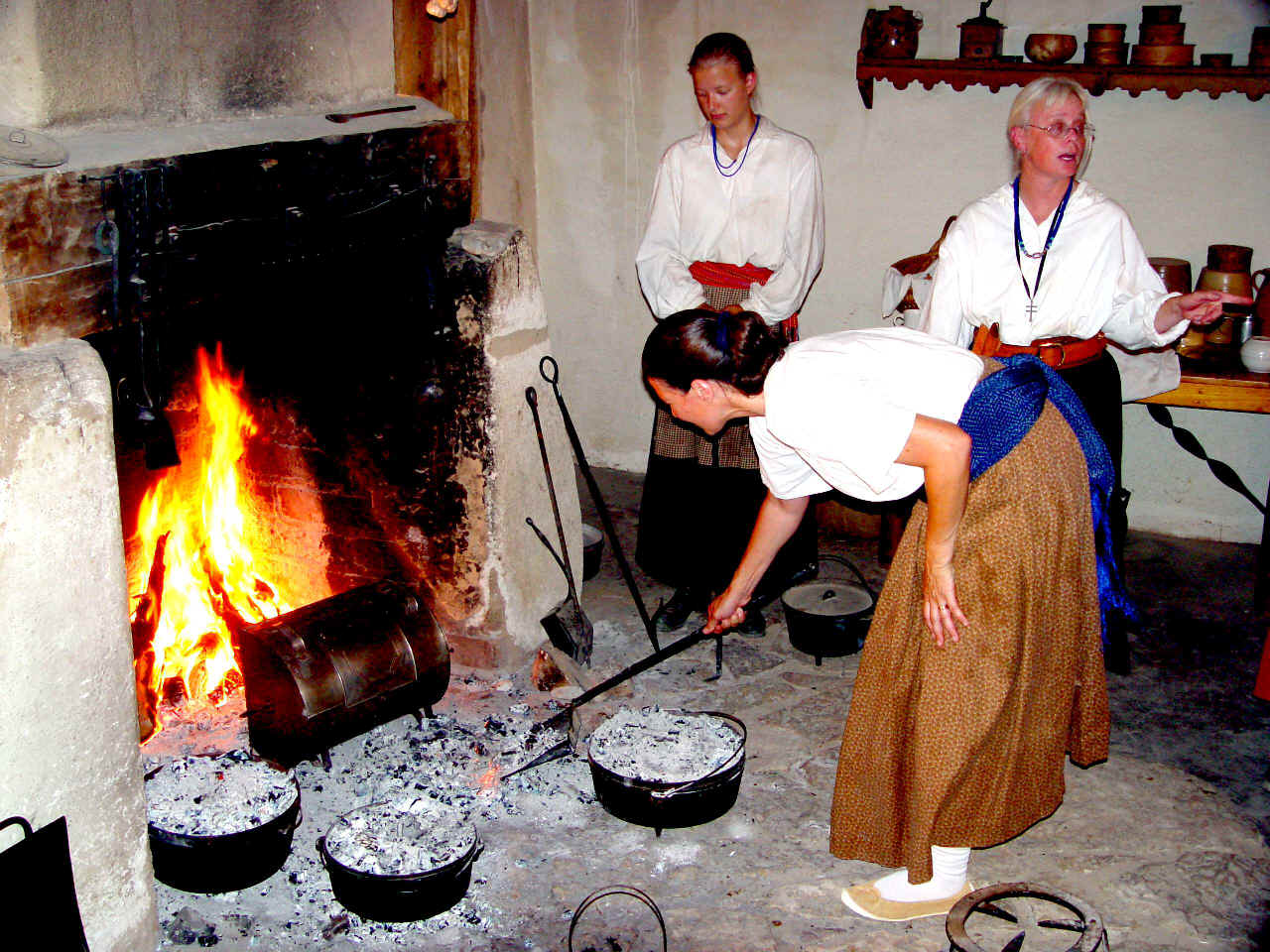
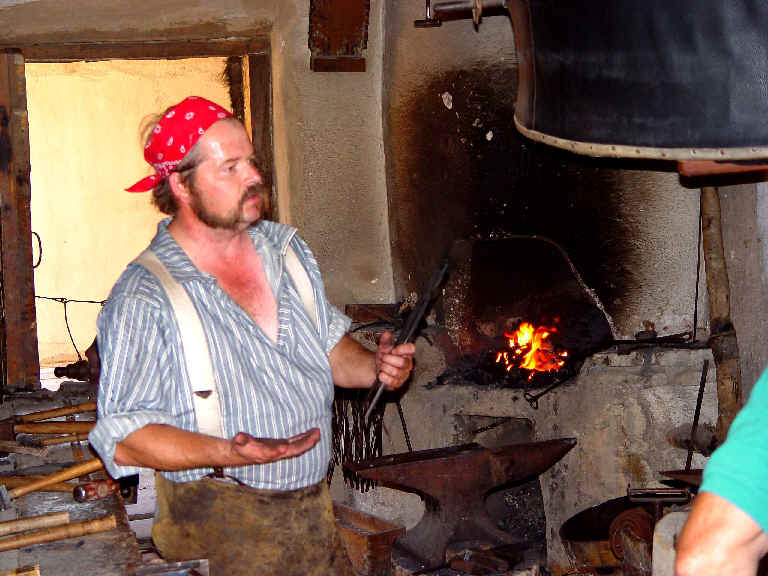
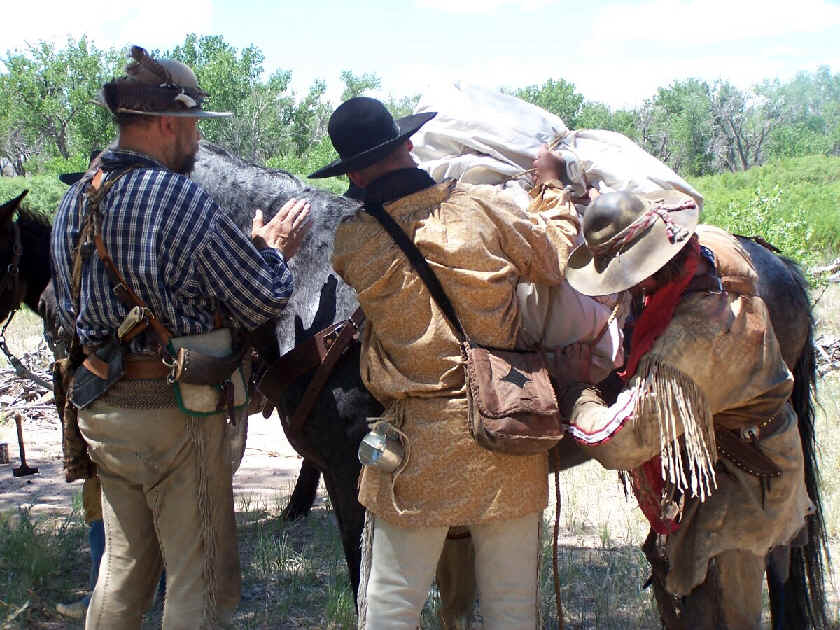
We
then went to Animas for a buffet dinner consisting of
chicken fried steak, or chicken breasts, mashed potatoes,
mixed vegetables, fruit and cake for dessert.
Upon
returning from dinner, the time shifted to 1845 and we
assumed our roles splitting into two groups, either becoming
a Topographical Engineer (a Topog) or an emigrant from the
east arriving on a wagon train. The emigrants had a lesson
on using flint and steel for fire starting. The camp had
been set up but due to the wind some of the tents had to be
set up again. I ended up sleeping under a wagon. One of the
party was a banjo player so he played for a while and folks
told stories around the fire. Mr Holt related his version of
Lewis Garrard's colorful tale of Long Hatcher's dissent into
Hell. (2)
I
found out later the next day that during night Lt
Richardson, a Topographical Engineer, had had a
kidney stone attack and was taken to the hospital.
Friday
up at sunrise
Tommy
made breakfast demonstrating dutch oven cooking: biscuits,
bacon and coffee. As all our oxen had been driven off during
the night, three of us went to the fort to see if we could
get a team to finish the drive to the fort. We ended up
trading four Mexican domestics for two oxen. After breakfast
Henry Crawford demonstrated daily horse care on Colonel, his
22 (going on 5) year old horse. We then broke camp, and
loaded the wagon with personal effects and drove to fort. We
were met by the head trader or Factor, Mr Luzader, and I was
hired at $75.00 per year on recommendation of Mr. Holt, now
the master carpenter, and Mr. Wood, the master blacksmith.
Some folks were hired as traders, some as hunter/trappers,
for the fort. The domestic were alreat at work. The Sargent
of the Dragoons asked me to relay a message concerning Lt
Richardson to the Captain of the Topographical Engineers, so
I interrupted the first table's breakfast. Something one
does not do lightly. Joe, the Blacksmith apprentice and I,
the carpenter apprentice were given the task to build two
Hudson Bay Ration Boxes which we could then used to store
our personal effects. As there was only one blacksmith
apprentice and one carpenter apprentice, we alternated roles
and did the wood and
iron work for our box.
About 4:00 had dinner: beans, buffalo roast, cornbread, and
apple pie – didn't wait for vinegar pie; it was still too
hot to serve.
Mr
Holt brought the news that that Mr Hunter, one of the young
hunter/trappers was overcome by heat earlier in the day and
had died. We needed to make or find a coffin for him. Since
he was short, we decided to use a gun case. I cleaned the
case while the domestics sewed a shroud for him. After
putting the body in the coffin, the domestics got permission
from the Factor to say the rosary over the body. ( “You
can preform all those Papist rituals, as long as they're out
of sight” was the way he put it.) One of the domestics was
overcome with sorrow and swooned clean away. As we were
taking a break under the portal, we were available to carry
her on a blanket to the plaza were the Factor provided a
bottle of champagne to arouse her, since no one had smelling
salts. After her revival, the Factor relented and allowed
them to continue in the plaza. After dark the factor
conducted a memorial service for Mr Hunter. Joe, being a
former Mexican laborer and having learn very good English,
translated for the domestics as they could speak and
understand only very rudimentary English.
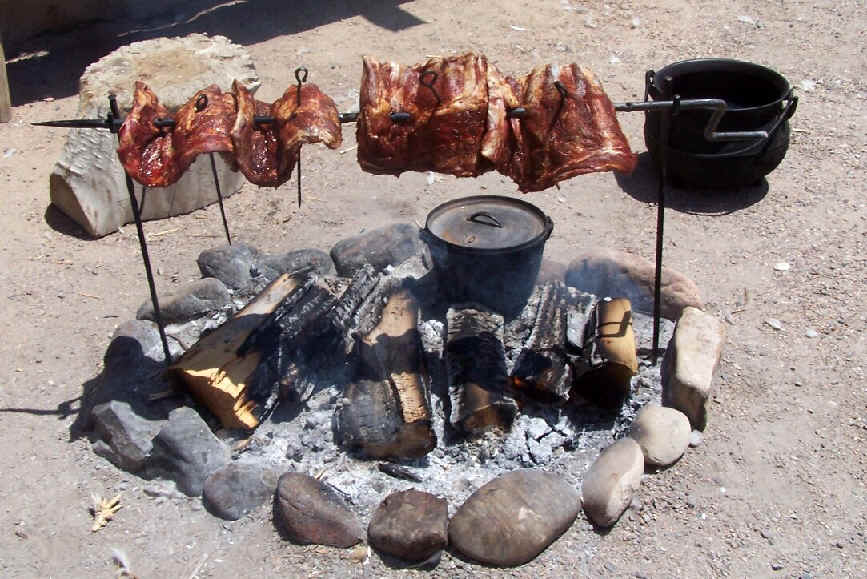
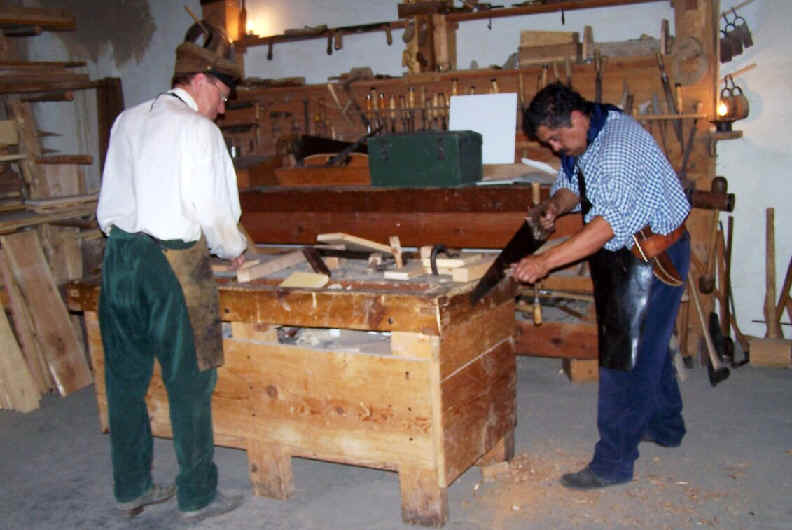
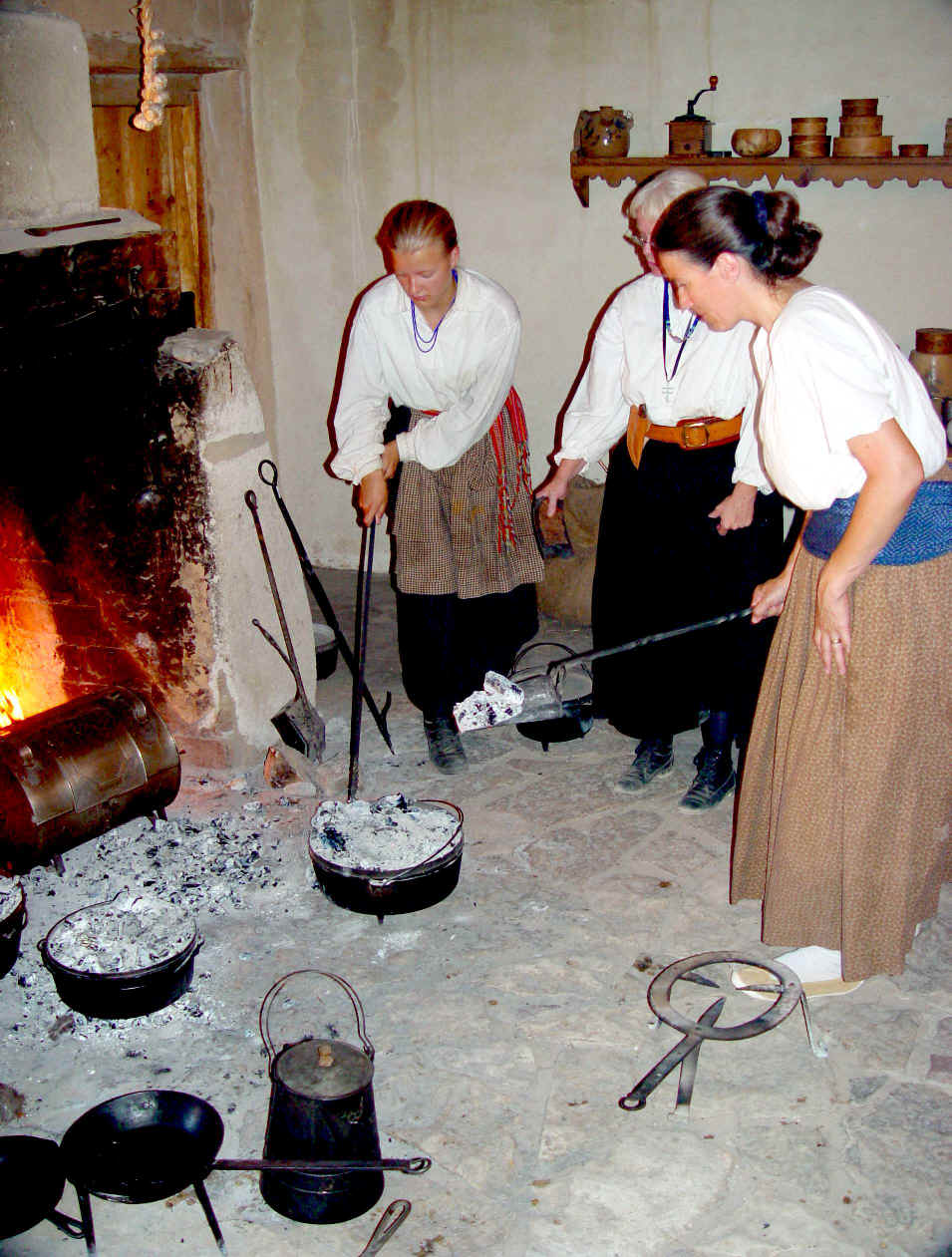
Meanwhile,
the Topogs had spent the day measuring and drawing the fort.
The hunter/trappers spent the day setting traps and other
camp duties.
I
had the 2-4 a.m. watch. Discovered that one of the peacocks
“guards” the sinks. He let everyone know when some one
walked past him. The wind had come up and it was cool on the
bastions, but still warm in the plaza.
Had to put on my wool shirt and then spent most of
the time on the bastions. One peahen was disturbed, don't
know if it started to fall off the chimney on which it was
roasting on or what but it started to cry, not sounding
normal then sounded OK when another answered and it started
to calm down. During my first rounds, I had forgotten that
there was a goat and her kid tied behind the kitchen. (The
domestics used her for milking.) She had a bell around her
neck. From then on noticed that she was moving almost
constantly. After a while the bell stopped; being not sure
if someone had snuck in and “stolen” her, I
investigated. As I eased around the corner she rang her
bell, like “it's OK I'm still here”. The almost full
moon set at end of watch, and
one of roosters started to crow. I woke Malichi, my relief,
and didn't let the rooster stop me from falling back to
sleep.
Saturday.
Up at sunrise, forge fired by 6:30 and working on our
projects. Factor told us to load a wagon with supplies.
After completing the loading, we went back to work. Mr. Holt
and Joe hitched the team and took the wagon to the
cottonwoods. Later a trader, Mr Robinson, came and informed
me that I was to draw a rifle and shot pouch from the trade
room and go with him as the wagon had been attacked. We
arrived on the scene, no team on the wagon, and the load had
been strewn about but none of the cases had been broken
open, Not even the barrel of brandy. Stood guard till Mr
Crawford, the assistant trader, came and scouted on horse
back. Mr. Holt arrived with the team and hitched the wagon;
we loaded the wagon and returned to the fort. As we were
unloading the wagon, Mr Robinson inventoried the load and
found that a case of rifles was missing.
Breakfast
this morning, served at 10:00, consisted of eggs, hotcakes
and bacon, and coffee.
Domestics
butchered three chickens, cleaned the birds and roasted them
over the fire on a spit. After the chickens were done they
roasted buffalo ribs over the fire.
Dinner,
served at 3:30 to 4:00: buffalo ribs, chicken, vermicelli,
tortillas and cornbread, lemonade and water. Vinegar pie for
dessert, a perfect substitute for lemon pie.
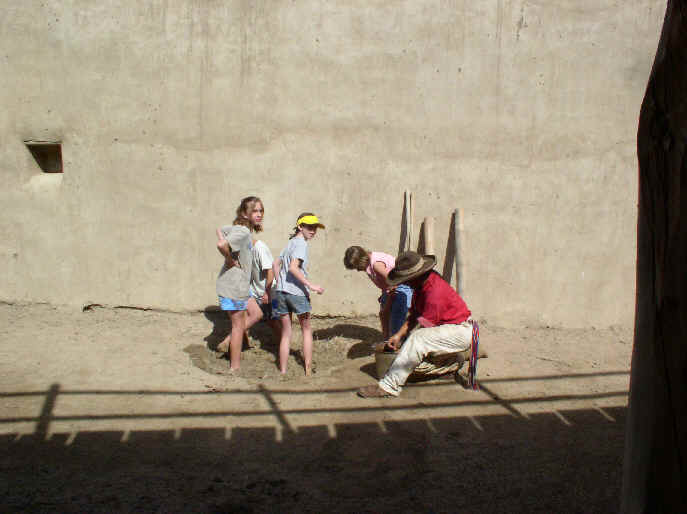
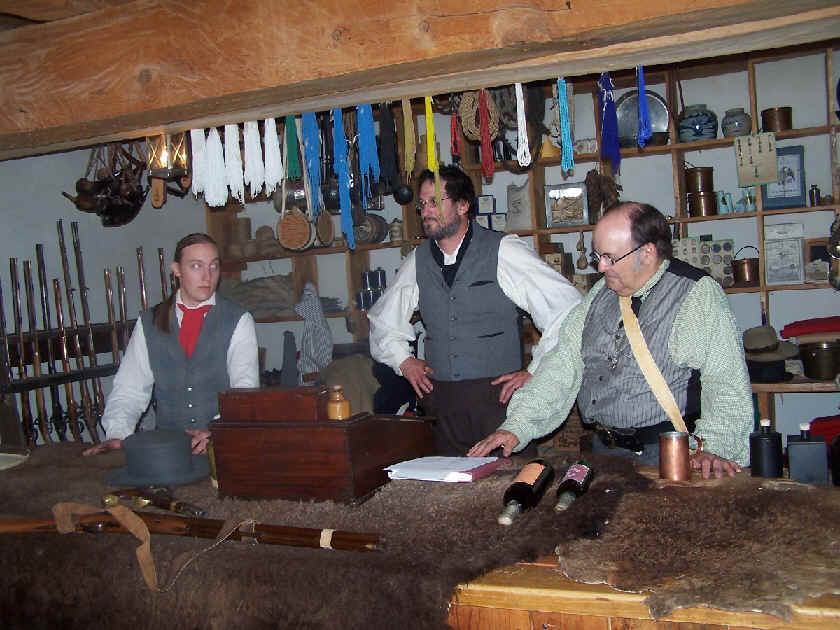
Continued
working till early evening. Being Saturday night, we broke
for the evening gathering in the plaza. Normal days at the
fort are from sun up, 5:30 a.m. till 10:30 or 11:00 p.m.,
depending on the workload. This being early summer the wagon
trains from the fort are all ready on the way to St. Louis,
and the trains from St. Louis haven't arrived yet so the
work load was light. The hunter/trappers had packed their
supplies on the mule and moved into the fort for the night.
The Fort William Thespian Society preformed William
Shakesphere's 'The Life and Death of Julius Caesar”. Never
realized it was a comedy. The banjo player played and then
stories were told, “The Ghost Deer” and “The
“Christmas Goose” were just two.
The
Topogs had spent the day using a plane table to record
sightings they had taken and practicing drawing with
perspective, and water coloring. In the evening they took
sighting of Jupiter and it's moons to check their
chronographs.
Sunday,
up with the sun again. Joe had the 2-4 watch but he hadn't
gone back to bed. He had stayed up and made coffee for us.
As it was Sunday it was slow day.
Breakfast was leftover buffalo roast, eggs, scrambled
eggs, chicken, tortillas, cornbread and coffee. There wasn't
any leftover pie. Our iron work was done, so we continued to
work on the boxes wooden parts. Joe managed to paint and
finish assembly on his. We were informed that the teamsters
hadn't water the oxen so I did. One of the oxen, either Rex
or Ely, tried to walk past the hose but touched it with his
front hoof. Since I was there, he waited until I moved the
hose and then, as I walked away, tentatively stepped over
the hose and continued
walking around the corral. We drew our
pay and said our goodbyes.
All
in all a very enjoyable and worthwhile experience. The
instructors were all topnotch. All the participants lived
their roles to the fullest. The time spent could have been
longer but I realize that would be harder to schedule. After
hiring on, the groups separated and didn't have a lot of
contact, which was probably realistic for the times, but
that means that there are at least four other stories like
this waiting to be written (traders, domestics, Topogs, and
hunters).
Postscript:
Mr Hunter didn't die, he was taken to a cool part of the
fort and when he was cooled down, home where after a night's
sleep in his own bed, it was reported that he's fine.
Lt
Richardson is recovering from his kidney stone treatment at
his parent's home. And at last report is doing fine also.
(1)
Tilden,
Freeman, “Interpreting Our Heritage”, page 9.
(2)
Garrard, Lewis, “Wah-To-Yah and the Taos Trail”, chap.
21
|